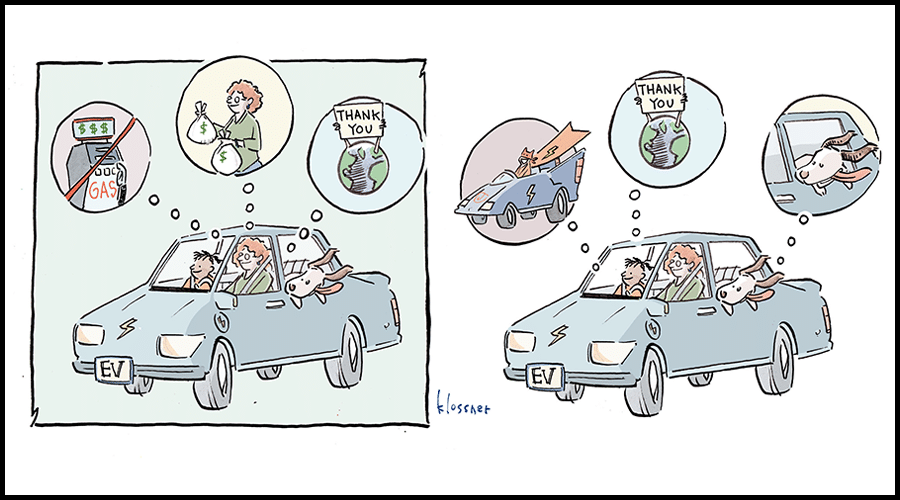These days, it’s getting more and more common to spot a Tesla or a Nissan LEAF during our daily drives—a sure sign that electric vehicles are shifting into the mainstream. Even better, a lot of the barriers that have deterred EV buyers in the past seem to be dropping away. Combine that with the myriad of EV benefits (cheaper cost of ownership, less maintenance, and way more fun), it’s hard for many households to justify not going electric. Charging stations are ramping up quickly, especially in cities, and last week the California-based EV start-up Lucid announced the first all-electric car that can drive more than 500 miles on a single charge (that’s roughly a sixth of the way across the U.S.!). So is “range anxiety” really a thing of the past? Suffice to say, we’re getting a heck of a lot closer.
Going the distance
Studies have found that the two main reasons that folks who are in the market for a new vehicle don’t consider EVs are the battery range and the lack of charging infrastructure. Like gas cars, EV batteries can’t drive forever— they only hold so much power before they need a “fill up.” Range anxiety is that nagging feeling that your car is going to run out of juice and leave you stranded before you’re able to recharge it. But we’re now at the point where inadequate range is no longer a reasonable excuse anymore. The new Lucid Air Dream is a range superstar, and it’s not the only EV that goes the distance. Tesla’s Model S Long Range is rated to go 405 miles per full charge, which is well beyond what most of us drive in a single day.
Granted, most of us can’t afford a high-end Lucid or Tesla. But even the more affordable EV models have a pretty decent range: around 350 miles per charge for the Tesla Model 3, nearly 260 miles for the Chevy Bolt, and 226 miles for the Nissan LEAF. Given that the average American drives 31 miles per day, according to the American Automobile Association, current models well exceed most people’s daily needs, making range anxiety a nonfactor for 95% of your driving occasions. An EV can be an ideal car both for everyday commuting and for running errands around town. AutoNation CEO Mike Jackson noted in February that range anxiety among EV owners is “dramatically disappearing,” since most people, “for their daily use around their home or office, they’re delighted to have an electric vehicle.”
The charging challenge
This brings us to the issue of EV charging. If you’re able to plug in your car at home, then neither battery range nor charging are really an issue. It’s an easy addition to make plugging in your vehicle part of your evening routine, just like charging your smartphone or tablet before bed. Currently, more than 80 percent of EV battery charging takes place at home overnight, according to the U.S. Department of Energy, whether through a standard household outlet, or a “fast charger” home charging unit.
More than 80 percent of EV battery charging takes place at home overnight
But not everyone has the ability to charge at home, and not every apartment complex or rental unit allows for overnight plug-ins. Right now, fewer than 10 percent of Americans have easy access to an EV charging station (within a quarter-mile of their home), and the folks that do are generally wealthy and white. It’s also no surprise that most EV owners today live in cities, since urban life improves your chances of finding a charging station (especially in an “EV-ready” city like San Jose, Denver, Los Angeles, or even Hartford). To make EVs more convenient, no matter their range, we need to greatly expand the nation’s charging network, including at workplaces, stores, schools, and other public places.
In his proposed infrastructure package, President Biden has called for adding another 500,000 charging stations in the U.S. in the coming years (up from around 104,000 today), many of them in low-income and rural areas. This will be a game-changer, especially in places with long driving distances. Early last year, ChargePoint, the world’s largest EV charging network, joined with NATSO, which represents America’s travel plazas and truck stops, to expand EV charging along highways and in rural communities—with the goal of installing chargers at more than 4,000 travel plazas and fuel stops by 2030. But until that happens, it’s wise to plan carefully if you’re taking an EV road trip, especially given the long(ish) wait times for charging (check out Gen180’s blog on the top 3 EV road trips).
EVs are easy
The bottom line? As batteries get more powerful, and as EV charging infrastructure expands, range anxiety is becoming a thing of the past. For the majority of Americans, EVs are a perfect fit. Here are some tips to make that fit even more perfect.
- Charge at home, which is way easier than dealing with gas stations. Plug in your EV every night before bed, and top it off as needed, and you generally won’t have to worry about finding the next charging station. A standard wall outlet can get you 50 miles overnight, and if you need more, look into installing a home fast-charger—many EV owners do (and benefit from a tax credit of up to $1,000).
- Join a national charging station network like ChargePoint or Electrify America, or use Tesla’s Supercharger network if you’re an owner. Networks provide charging convenience through their smartphone apps and allow for automatic cashless payments.
- EV ownership cures range anxiety. 96% of EV owners say they would buy or lease another electric vehicle the next time they were in the market for a new car. Most people rarely (if ever) run out of gasoline in their ICE vehicles because they’ve learned over time when they need to fill up. The same rings true for EVs. With home charging and an ever-increasing charging infrastructure range, anxiety should be a thing of the past.
- Buy a plug-in hybrid, which will get you from Boston to Los Angeles without any extra planning or charging stops (though you’ll still need to fill up on gas). Unlike a full battery electric vehicle (BEV), a plug-in hybrid runs solely on electricity for short distances, but when the battery starts getting low, the gas engine takes over. You won’t reap the full benefits of a BEV as there are effectively two engines to maintain, but for long commuters that don’t have access to charging near your work, it may make sense for your household.
For everyday wheels, driving an EV today is a near-perfect solution, especially if you can charge your vehicle at home. The EV experience is one of more convenience, a luxury feel with a sports car zip, and with more than enough range to cover most daily needs. And as the nation’s charging network expands, fueling up on the go will only get easier—turning any lingering EV anxiety into full-on EV excitement.
In celebration of National Drive Electric Week 2021 (Sept 25 – Oct 3), Generation180 is excited to bring you a whole new slate of electrifying virtual events. From refitting gas stations to become EV charging stations, to electric school buses, EV journalism, policy, and more, we’ve gathered experts to help you understand what the EV transition in 2021 and beyond looks like. Find out more >>















